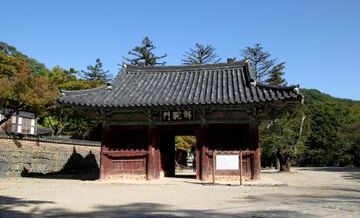"마곡사 해탈문"의 두 판 사이의 차이
(→영문) |
|||
| (다른 사용자 한 명의 중간 판 2개는 보이지 않습니다) | |||
| 1번째 줄: | 1번째 줄: | ||
| − | |||
{{문화유산정보 | {{문화유산정보 | ||
|사진=마곡사해탈문.jpg | |사진=마곡사해탈문.jpg | ||
| 30번째 줄: | 29번째 줄: | ||
'''Haetalmun Gate of Magoksa Temple''' | '''Haetalmun Gate of Magoksa Temple''' | ||
| − | Haetalmun | + | Haetalmun, meaning “gate of nirvana,” is one of the gates leading into a Buddhist temple. It is said that a person who goes through this gate leaves the secular world, enters the world of the Buddha, and gains the possibility of attaining nirvana, i.e. freedom from the cycle of reincarnation. |
| − | It is unknown | + | Haetalmun Gate of Magoksa Temple is located on the path leading to the northern section of the temple. It is unknown when this gate was first built, but records state it was repaired in 1846 and 1910. Inside the structure are four large statues. To the left is a wrathful guardian named Narayana and Samantabhadra (the Bodhisattva of Great Conduct). To the right is another wrathful guardian named Guhyapada and Manjusri (the Bodhisattva of Wisdom and Insight). Wrathful guardians are said to protect the teachings of the Buddha, and statues of them are thus often located inside one of the gates leading into a Buddhist temple. The two bodhisattvas are depicted as child attendants, with Manjusri seated on a lion and Samantabhadra seated on an elephant. |
| − | |||
| − | Inside the structure | ||
===영문 해설 내용=== | ===영문 해설 내용=== | ||
| − | 해탈문은 | + | 일반적으로 해탈문은 사찰 영역으로 진입하는 여러 문 중 하나이다. 이 문을 지나면 속세를 벗어나 부처님의 세계에 들어가 해탈을 할 수 있게 된다는 상징적인 의미를 갖는다. |
| − | |||
| − | |||
| − | 건물 내부에는 중앙에 난 통로를 기준으로 왼쪽에는 나라연금강과 보현보살상이, 오른쪽에는 밀적금강과 문수보살상이 배치되어 있다. 금강역사는 | + | 마곡사 해탈문은 북원으로 진입하는 길에 위치하고 있다. 정확한 창건 연대는 알 수 없고, 1846년과 1910년에 중수되었다는 기록이 남아 있다. 건물 내부에는 중앙에 난 통로를 기준으로 왼쪽에는 나라연금강과 보현보살상이, 오른쪽에는 밀적금강과 문수보살상이 배치되어 있다. 금강역사는 불법을 지키는 수호자로 여겨지기 때문에, 사찰 입구에 위치한 문에는 금강역사상이 배치된다. 두 보살은 동자의 모습을 하고 있으며, 문수보살은 사자 위에 앉아 있고 보현보살은 코끼리 위에 앉아 있다. |
=='''참고자료'''== | =='''참고자료'''== | ||
2020년 8월 4일 (화) 18:04 기준 최신판
| 마곡사 해탈문 Haetalmun Gate of Magoksa Temple |
|
 마곡사해탈문, 국가문화유산포털, 문화재청. |
|
| 대표명칭 | 마곡사 해탈문 |
|---|---|
| 영문명칭 | Haetalmun Gate of Magoksa Temple |
| 한자 | 麻谷寺 解脫門 |
| 주소 | 충청남도 공주시 사곡면 운암리 565 |
| 지정번호 | 충청남도 문화재자료 제66호 |
| 지정일 | 1984년 5월 17일 |
| 분류 | 유적건조물/종교신앙/불교/문 |
| 시대 | 조선시대 |
| 수량/면적 | 1동 |
| 웹사이트 | 마곡사해탈문, 국가문화유산포털, 문화재청. |
|
|
|
해설문
국문
해탈문(解脫門)은 마곡천을 중심으로 남원과 북원으로 구별되는 마곡사의 남원에 위치한다. 천왕문과 함께 북원으로 진입하는 정문으로 이용된다. 이 문을 지나면 속세(俗世)를 벗어나 불교 세계(法界)로 들어가게 되는 것이며, 이는 곧 해탈하게 된다는 상징적인 의미를 갖는다. 건립 시기는 자료마다 다르지만, 12세기 말에서 15세기 후반으로 추정된다. 현재 남아있는 건물은 조선 후기 중건 당시에 건립된 건물로 판단된다. 조선 후기 전통 불교 건축물의 장식적 특징이 잘 남아 있으며, 건축적 외관의 조화가 훌륭하다고 평가되고 있다.
홍살대를 꽂아 통로를 구획하였는데, 중앙 통로를 기준으로 왼쪽에는 금강역사상(金剛力士像)과 보현동자상(普賢童子像)이 있고, 오른쪽에는 금강역사상과 문수동자상(文殊童子像)을 안치하였다.
영문
Haetalmun Gate of Magoksa Temple
Haetalmun, meaning “gate of nirvana,” is one of the gates leading into a Buddhist temple. It is said that a person who goes through this gate leaves the secular world, enters the world of the Buddha, and gains the possibility of attaining nirvana, i.e. freedom from the cycle of reincarnation.
Haetalmun Gate of Magoksa Temple is located on the path leading to the northern section of the temple. It is unknown when this gate was first built, but records state it was repaired in 1846 and 1910. Inside the structure are four large statues. To the left is a wrathful guardian named Narayana and Samantabhadra (the Bodhisattva of Great Conduct). To the right is another wrathful guardian named Guhyapada and Manjusri (the Bodhisattva of Wisdom and Insight). Wrathful guardians are said to protect the teachings of the Buddha, and statues of them are thus often located inside one of the gates leading into a Buddhist temple. The two bodhisattvas are depicted as child attendants, with Manjusri seated on a lion and Samantabhadra seated on an elephant.
영문 해설 내용
일반적으로 해탈문은 사찰 영역으로 진입하는 여러 문 중 하나이다. 이 문을 지나면 속세를 벗어나 부처님의 세계에 들어가 해탈을 할 수 있게 된다는 상징적인 의미를 갖는다.
마곡사 해탈문은 북원으로 진입하는 길에 위치하고 있다. 정확한 창건 연대는 알 수 없고, 1846년과 1910년에 중수되었다는 기록이 남아 있다. 건물 내부에는 중앙에 난 통로를 기준으로 왼쪽에는 나라연금강과 보현보살상이, 오른쪽에는 밀적금강과 문수보살상이 배치되어 있다. 금강역사는 불법을 지키는 수호자로 여겨지기 때문에, 사찰 입구에 위치한 문에는 금강역사상이 배치된다. 두 보살은 동자의 모습을 하고 있으며, 문수보살은 사자 위에 앉아 있고 보현보살은 코끼리 위에 앉아 있다.
참고자료
- 문화사업단 休知通(휴지통), 네이버 블로그 https://blog.naver.com/purers/220749825518 -> 문수보살, 보현보살 세부 사진
- 대한불교진흥원 https://www.kbpf.org/134277/134277/ -> 해탈문 의미, 보살상 위치 의미 등 설명
- 산사, 한국의 산지 승원 http://www.koreansansa.net/ktp/sansa/sansa_020404.do -> 중수 기록 확인. 판벽 마감을 특징으로 언급.